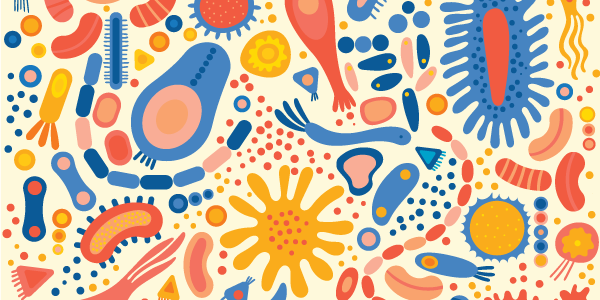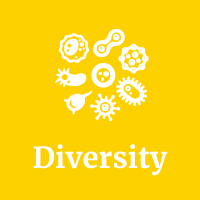
Microbial Diversity Quiz
The microbiome describes a characteristic microbial community, occupying a well defined and specific habitat, e.g. the microbes in the gut and other specific areas of the human and animal body, the marine environment, soil, plants, food and many more. The living microbial community itself is called microbiota. Microbiomes include bacteria, protozoa, fungi, archaea, and viruses. Their diversity differs depending on a variety of factors. Microbiomes have many essential functions in the environments they live in, and researchers are only now uncovering what they do and why it is important. You probably knew that millions of microbes live in our bodies. But are you aware of the answers to the following five questions?
Microbial Diversity Quiz
Question 1 |
How large is the biggest virus?
A | up to a diameter of 10 nanometers (1 nanometre is a billionth of a metre, so viruses are tiny) |
B | 200 nanometers or more |
C | 1 millimeter or more |
Question 1 Explanation:
Giant viruses were initially defined by their physical size as allowing visibility by a light microscope (so actually they are still tiny!). Researchers are now thinking about changing how to classify viruses by not just looking at their size, but also their genes. That’s still under discussion, though, so let’s stick with giant viruses for now!
Question 2 |
Does species richness (the number of organisms of one type of microbe) and diversity (of different microbe types) in animals and humans usually increase or decrease during microbial imbalance or dysbiosis?
A | Increase |
B | Decrease |
C | Neither increase, nor decrease |
Question 2 Explanation:
A balanced microbiota composition is important for keeping up the microbiome’s normal function in a specific habitat, such as e.g. the gut, skin and mouth, etc. When this balance is disturbed, the abundance of beneficial microbes is decreasing, while other non-beneficial microbes increase. This is usually combined with a loss of species richness and diversity.
Question 3 |
Every time you swallow a mouthful of seawater while swimming at the beach, you are taking in about as many viruses as there are…?
A | people in North America (around 330 Million) |
B | people in New York (around 9 Million) |
C | people fit in the Madison Square Garden (around 20.000) |
Question 3 Explanation:
Despite the high abundance of marine viruses — and the key role that these infectious agents seem to play in global processes like the carbon cycle — scientists still know relatively little about the variety of viruses in the ocean and other habitats. In 2015 a team claimed to have found 5,476 distinct kinds of viruses in the ocean. In 2016 the same team updated its count to 15,222. However, according to the latest count, the oceans contain almost 200,000 different viral populations. Scientists continue to investigate the marine microbiota as there remains so much more to learn.
Question 4 |
How many microbial cells can be found in 1g of rumen content (rumen = first forestomach of ruminants, like cattle, goat and sheep, etc.)?
A | 1000 |
B | up to 1 Million |
C | up to 1x1013 |
Question 4 Explanation:
The rumen harbours specific microbiota that helps the host animal to ferment plant matter that cannot be digested by their own digestive system. Depending on the compartment of the rumen (solid digesta, liquid digesta, and rumen wall), the number of microbial cells can be up to 10x1013 cells/g.
Question 5 |
How many of the known bacteria can be grown under laboratory conditions?
A | depending on the habitat between 0.01 and 70% |
B | about 1% |
C | about 30% |
Question 5 Explanation:
It has long been speculated that about 1% of all known bacterial taxa can be grown under laboratory conditions (= cultured). However, more and more researchers claim that this value under- or overrepresents the actual number of culturable bacteria. The latest meta-analyses suggest that depending on the habitat, between 0.01 and 70% of the microbes can be cultured. However, we should be aware that these numbers might change over time due to large efforts of scientists to culture the uncultured bacteria and due to re-analysing the current knowledge. While you are doing this quiz, the numbers might have changed already.
There are 5 questions to complete.
You have completed
questions
question
Your score is
Correct
Wrong
Partial-Credit
You have not finished your quiz. If you leave this page, your progress will be lost.
Correct Answer
You Selected
Not Attempted
Final Score on Quiz
Attempted Questions Correct
Attempted Questions Wrong
Questions Not Attempted
Total Questions on Quiz
Question Details
Results
Date
Score
Hint
Time allowed
minutes
seconds
Time used
Answer Choice(s) Selected
Question Text
All done
Need more practice!
Keep trying!
Not bad!
Good work!
Perfect!



